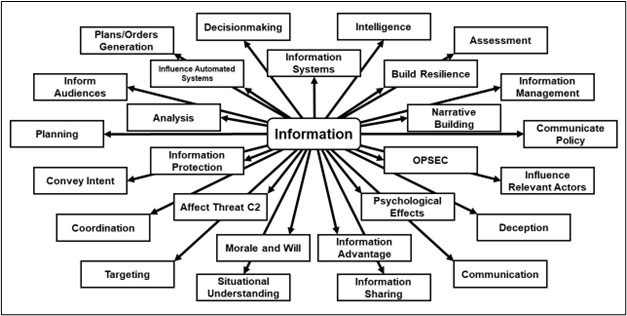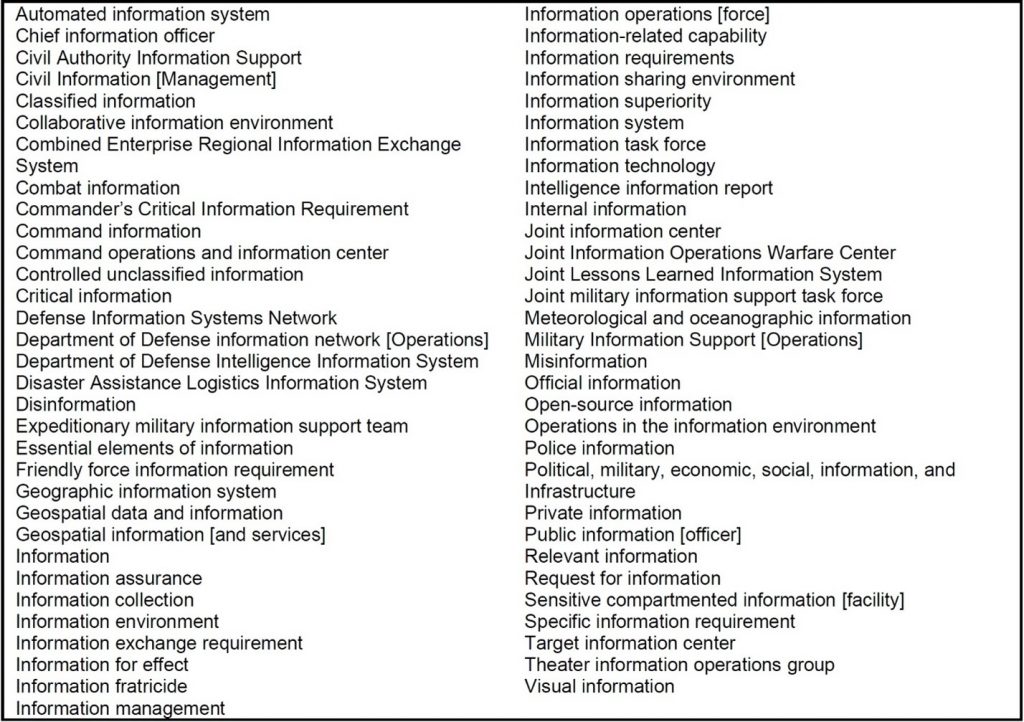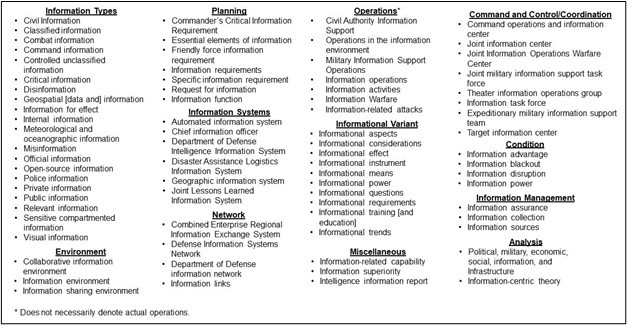Within the Department of Defense there is growing emphasis on information-related concepts intended to combat adversary influence efforts and the threat they pose to US national security. The problem? Emphasis on information as an overarching concept predisposes leaders to view information as a capability rather than as a tool that capabilities use. Information is merely a multidiscipline enabler—while influence consists of operations that affect adversary thinking, decision-making, and behavior. And yet despite the fact that information and influence are separate and distinct, military terms and phrases with the word information are commonly treated as substitutes for influence activities. Until policy and doctrine reflect that fundamental reality, US military efforts to employ influence capabilities will continue to fall short.
DoD Usage
Historically, DoD described information as a tool that enabled analysis, planning, decision-making, and the execution of operations. That is the context in which information operations (IO) developed as an integrating staff function. That context was the basis for Army usage in the 1996 edition of Field Manual (FM) 100-6, Information Operations, which described a global information environment, or GIE, as “all individuals, organizations, or systems, most of which are outside the control of the military or National Command Authorities, that collect, process, and disseminate information to national and international audiences.”
Within the GIE, there was the military information environment, or MIE, defined as “the environment contained within the GIE, consisting of information systems (INFOSYS) and organizations—friendly and adversary, military and nonmilitary, that support, enable, or significantly influence a specific military operation.” The MIE explicitly described influence as being part of an information environment.
The 1996 Army approach to describing information evolved in subsequent editions of FM 3-13, which replaced FM 100-6. The FM 3-13 title even changed from Information Operations to Inform and Influence Activities in the 2013 edition before reverting back in the 2016 edition. The Army’s growing focus on information coincided with a similar change in joint doctrine.
The 1998 edition of Joint Publication (JP) 3-13, Joint Doctrine for Information Operations defined IO as “actions taken to affect adversary information and information systems while defending one’s own information and information systems.” That simple definition did not mention influence, but various sections of the publication used such phrases as “influenced by IO,” “offensive IO,” “favorably influence the populace,” and “defensive IO.” It was unclear even then how a coordinating staff function could be offensive or defensive, much less how a staff element conducted operational activities.
The 2014 edition of JP 3-13 redefined IO as “the integrated employment, during military operations, of IRCs [information-related capabilities] in concert with other lines of operation to influence, disrupt, corrupt, or usurp the decision making of adversaries and potential adversaries while protecting our own.” This definition listed influence as an IO activity although IO was supposed to be solely an integrating staff function. The joint staff even renumbered several previously distinct joint publications to be subordinate IO publications. For example, JP 3-53, Doctrine for Joint Psychological Operations was renumbered to JP 3-13.2. In 2022, JP 3-04 superseded JP 3-13 and replaced the IO construct with a much broader one that focused not just on information operations but on information itself. JP 3-04 also replaced IO with operations in the information environment (OIE), which it defined as “military actions involving the integrated employment of multiple information forces to affect drivers of behavior by informing audiences; influencing foreign relevant actors; attacking and exploiting relevant actor information, information networks, and information systems; and protecting friendly information, information networks, and information systems.” When JP 3-13 became obsolete, JP 3-13.2 officially renumbered back to JP 3-53 for its upcoming revision.
Previously, influence activities were “information-related.” The new paradigm removes the qualifier “related” and collectively refers to the disparate activities and organizations like psychological operations, cyberspace forces, electromagnetic spectrum operations, and combat camera as “information forces.” Information became something far larger and more broadly conceptualized. The profound change in perspective shows in the DoD definition for the information environment (IE), which is “the aggregate of social, cultural, linguistic, psychological, technical, and physical factors that affect how humans and automated systems derive meaning from, act upon, and are impacted by information, including the individuals, organizations, and systems that collect, process, disseminate, or use information.” Between 1996 and 2022, the definition of the information environment fundamentally changed, reflecting a deep transformation in how DoD views information. Analysis of usage throughout JP 3-04 resulted in figure 1, which depicts an interpretation of the new information-centric paradigm, illustrating the depth and breadth of the new concept rather than a comprehensive listing.
The changed perspective is an acknowledgement that information is vital to operations. This is undoubtedly true, but that acknowledgement has gained momentum that has carried the shift too far. By 2010, there was an attempt to address the need to influence foreign individuals, groups, and populations without using what were deemed to be problematic terms like psychological operations. Then Secretary of Defense Robert M. Gates formally directed a change in terminology, noting that “although PSYOP [psychological operations] activities rely on truthful information, credibly conveyed, the term PSYOP tends to connote propaganda, brainwashing, manipulation, and deceit.” As a substitute term for activities intended to influence, DoD chose MISO, or military information support operations.
The word information now covers a huge variety of functions, specialties, and systems like computers and networks, data collection and storage, data for planning, and, of course, influence activities. Figure 2 lists the most numerous terms in current, approved joint and Army doctrine containing the word. Figure 3 lists uses of the word in the most recent publications—JP 3-04 and ADP 3-13 (2022 and 2023, respectively).
While use of the word information continues to expand, there are patterns. The twelve broad categories shown in Figure 4 all touch upon information in some way. The relationships are not so close as to be logically under one overarching construct, yet DoD lumps disparate functions, activities, and operations under information, forming an incongruent mix of square pegs and round holes.
Information Versus Influence
The Secretary of Defense–directed change to the function from psychological operations to military information support operations is an excellent example of the problems overuse of the word information causes. Military information support operations is a confusing hodgepodge of misapplied terms. First, DoD defines military information as “information under the control or jurisdiction of the Department of Defense, its departments, or agencies, or of primary interest to them.” Second, the term information support is also an issue because it is an information technology term for enabling services. Even minus the redundant word “military” (which can be presumed for any subject discussed in military doctrine), “information support operations” could be interpreted as general computer-related support or knowledge-management activities. The name change would have achieved greater clarity if MISO stood for military influence and shaping operations, as that clearly reflects what the function does. The announcement of the department-wide shift from PSYOP to MISO stated that the latter term “more accurately reflects the nature of these activities.” As a term and acronym, MISO does no such thing.
Moving to Clarity
The foundation for DoD information activities resides in the information joint function, which “encompasses the management and application of information and its deliberate integration with other joint functions to influence relevant actor perceptions, behavior, action, or inaction and to support human and automated decision making.” The OIE conceptually aligns with the joint function, despite the IE being a notional construct devised “to help identify, understand, and describe how those often-intangible factors may affect the employment of forces and bear on the decisions of the commander.” Since the IE is notional, then operations cannot occur in it.
A fundamental problem with the overarching information construct is that derivative terms lack clear definitions and obvious meanings—as in the Army’s use of “information effect” in Army Doctrine Publication 3-13, Information. At least JP 3-04 uses “psychological effect” to denote the changes influential messaging can elicit. Aside from long-established use, a reader can easily conclude that psychological indicates a reference to the mind or thinking and effect means some impact or change. There is no comparable clear chain of reasoning for information effect. It could apply to numerous fields like computer science, communications, and network operations. Logically, any term with the word psychological does not apply to any of those specialties.
Whereas information activities is vague and ill-defined, influence activities can be simply and clearly defined as actions executed to change or reinforce how people think, feel, and act. There is no mention of information in this proposed definition because information is an enabler of and a tool for influence; it does not define influence. There are many ways to influence human behavior, information being one means to do so.
US military culture has an affinity for new terms, acronyms, and buzzwords. In the case of influence, the mislabeling of a vital function inhibits clear understanding of what influence capabilities contribute to military operations. An important outcome of clear terms would be a sharp distinction between information-focused activities and influence-focused activities. Information and influence are not synonyms, so the two activities are not the same. To achieve clarity, there is a need for an influence paradigm.
A transition to an influence paradigm will face formidable resistance. Over the last eighty or so years, political and military leaders have directed various name changes to allay concerns about using terminology that is believed to be problematic—like psychological. However, a necessary result of a paradigm shift would be to establish an influence function equal to the other joint functions and a corresponding Army warfighting function. It is in terms of function that the most important difference between information and influence emerges.
Information is inherent to all the Army’s warfighting functions; therefore, it should not be a separate function. Influence of foreign individuals and groups, by contrast, is not inherent to most Army warfighting functions—except for fires and movement and maneuver, but even in those functions, influence is not a primary focus. Influence is an operational activity and ultimately focuses on the human dimension rather than the information dimension. These facts sharply and clearly distinguish influence from information. DoD policy, Army doctrine, and operations do not currently reflect this distinction. It is time they are changed to do so.
Ian J. Courter is an analyst and doctrine developer for the United States Army John F. Kennedy Special Warfare Center and School. He holds a BA from Murray State University and an MA from Southern Illinois University at Carbondale. Courter is a prior service psychological operations soldier and linguist with numerous deployments to South America, Europe, and the Middle East to conduct influence activities in counterinsurgency, major combat operations, and peacekeeping.
The views expressed in this article are those of the author and do not reflect the official position of the United States Military Academy, the Department of Army, the United States Department of Defense, or the US Government. The appearance of external hyperlinks does not constitute endorsement of the linked websites or the information, products, or services contained therein.
Note: While all cited material for this article is unclassified, some sources reside only on CAC-enabled sites. However, the Defense Office of Prepublication and Security Review cleared for publication all content in this article, as did the United States Army John F. Kennedy Special Warfare Center and School public affairs and G2.
Image credit: Esercito Italiano, via Wikimedia Commons






